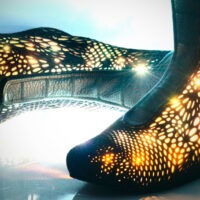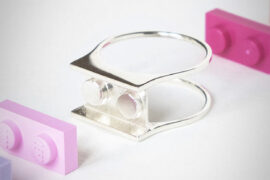At only 12.7 MB, this new CAD package packs a punch! Although it may come with a bit of a steep learning curve, Monolith enables users to vary the quantity of multiple materials on a voxel-by-voxel basis. New 3D Printing technologies – such as those seen in Stratasys’ Objet multi-material 3D printers – allow the creation of monolithic hinges with a varying gradient of flexible and hard materials and color options.
With Monolith, users are no longer confined to just designing with just shape and form…they are now able to mix materials in a seemingly endless array of design possibilities.
Created by Panagiotis Michalatos, assistant professor of architecture at the Harvard School of Design, and Andrew Payne, Architect and graduate from the Harvard School of Design, Monolith was created with the purpose of filling a hole in the Landscape of CAD software, namely how one can fully explore the possibilities of multi-material 3D Printing in Design.
“What’s a voxel? Well, think of it like a three-dimensional pixel. In fact, the word voxel is short for volumetric pixel. Much like a pixel, which describes the attributes (like color) of an element within a larger composition (an image); a voxel can describe attributes about a physical location within a 3D volume. These attributes can include information about its material properties, density, color, and more.”

This ‘Voxel Modeling Engine’ is pretty amazing – you can have full control over how a part may look and feel without feeling hungup on how to design for manufacturing and assembly.
Need to cover a certain part of your model with a rubber material for better grip properties?
No worries – just model accordingly and vary the gradient between the boundaries so that there’s a seamless change between materials. Using an Objet Connex, for example, this is important. Back in 2013 when I attended the SolidWorks 2013 Object launch, the reps gave us a few pieces of printed toolboxes – complete with flexible hinges. Sadly, the hinges broke off in a day or two, right near the edge where it went from hard to flexible. Had the materials been mixed by design using ‘Voxel modeling’ this problem would have been avoided. Attention Rhino/Grasshopper users! You can link the two programs to make designing with Monolith easier.
Here’s a breakdown of how Monolith works with existing workflows:
Features:
- Parametric/Function-based Design
- Free Paint
- Image Sweep (blend two or more images along an axis)
- Twist
- Inside/Out
- Gaussian Blur
- Symmetry
- Minimum (Erosion)
- Maximum (Dilation)
- Import Slices
- Export Slices
- Export Meshes
- Import/Export Voxel Files (.vol)
- Saving with Resources (.lith)
- Bitmap Patterns
- Mapping
- Voxel Patterns
- Topological Optimization
Be forewarned: Monolith has a steep learning curve. I spent an hour playing with the features creating some quick designs. The product documentation and tutorials are extremely well-done, but more tutorials would be appreciated. There are also simulation features which I am still trying to figure out – these are extremely promising for creating high performance parts, one could imagine. Combining 3DP and FEA is still in it’s infancy, and so far, only been tested on single-material pieces.





Monolith is available for download here – give it a shot and tell us what you think!




![6 Types of Civil Engineering Drawings [Detailed Guide]](https://www.solidsmack.com/wp-content/uploads/2023/12/Civil-Engineering-Drawings-270x180.jpeg)

